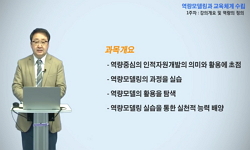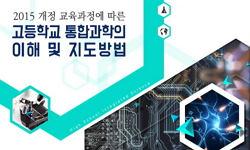The purpose of this study was to analyze chemistry textbooks and teachers’ guidebooks from the perspective of ‘Ignorance’, one of the important features of model. This is because the emphasis is on developing modeling capabilities for students i...
http://chineseinput.net/에서 pinyin(병음)방식으로 중국어를 변환할 수 있습니다.
변환된 중국어를 복사하여 사용하시면 됩니다.
- 中文 을 입력하시려면 zhongwen을 입력하시고 space를누르시면됩니다.
- 北京 을 입력하시려면 beijing을 입력하시고 space를 누르시면 됩니다.


2009·2015 개정 교육과정 화학 I 및 화학 II 교과서 및 교사용 지도서에 제시된 산·염기 모델 내용에 대한 ‘이그노런스’ 분석 = Analysis of ‘Ignorance’ in Acid-base Models Contents of Chemistry I and Chemistry II Textbooks & Teacher’s Guides in 2009 & 2015 Revised Curriculum
한글로보기https://www.riss.kr/link?id=A106912352
- 저자
- 발행기관
- 학술지명
- 권호사항
-
발행연도
2020
-
작성언어
Korean
- 주제어
-
등재정보
KCI등재,SCOPUS,ESCI
-
자료형태
학술저널
-
수록면
175-188(14쪽)
-
KCI 피인용횟수
0
- DOI식별코드
- 제공처
- 소장기관
-
0
상세조회 -
0
다운로드
부가정보
다국어 초록 (Multilingual Abstract)

The purpose of this study was to analyze chemistry textbooks and teachers’ guidebooks from the perspective of ‘Ignorance’, one of the important features of model. This is because the emphasis is on developing modeling capabilities for students in the 2015 Revised Curriculum. For this, Arrhenius model and Brønsted–Lowry model were selected as acid and base models in neutralization reaction which are important contents in chemistry curriculum. The analysis criteria of this study were extracted by analyzing previous studies and four general chemistry textbooks dealing with ‘Ignorance’ related to acid and base neutralization reaction. Based on the analysis criteria, we analyzed nine chemistry I textbooks and teacher’s guides and six chemistry II textbooks and teacher’s guides of the 2015 revised curriculum. In addition, we analyzed contents of four chemistry I textbooks and teacher’s guides and three chemistry II textbooks and teacher‘s guides in the 2009 revised curriculum for comparison according to revised curriculums. We analyzed the contents related to the concept of ‘neutralization reaction’, ‘neutrality’, ‘quantitative relation of neutralization reaction’, ‘degree of ionization’, and ‘ionization constant’. Based on the results of this study, we proposed a way to present ‘Ignorance’ of the models in teachers’ guidebooks that chemistry teachers can understand ‘Ignorance’ of model and teach modeling capabilities for students.
이 연구에서는 모델의 중요한 특징 중 하나인 ‘이그노런스’의 관점으로 화학 교과서 및 교사용 지도서의 내용을 분석하 였다. 이는 2015 개정 교육과정에서 학생들의 모델링 역량을 기르는...
이 연구에서는 모델의 중요한 특징 중 하나인 ‘이그노런스’의 관점으로 화학 교과서 및 교사용 지도서의 내용을 분석하 였다. 이는 2015 개정 교육과정에서 학생들의 모델링 역량을 기르는 것을 강조하고 있기 때문이다. 화학 교육과정에서 중요하게 다루는 내용인 산과 염기의 중화반응에 관련된 모델로 Arrhenius 모델과 Brønsted–Lowry 모델을 선정하고, 이에 관련된 ‘이그노 런스’를 다룬 선행 연구와 대학 일반화학 교재 4종을 분석하여 연구의 분석 기준을 추출하였다. 추출한 분석 기준으로 2015 개 정 교육과정의 화학 I 교과서 및 교사용 지도서 9종과 화학 II 교과서 및 교사용 지도서 6종을 분석하였다. 또한 개정 교육과정에 따른 내용의 차이를 비교하기 위해 2009 개정 교육과정의 화학 I 교과서 및 교사용 지도서 4종 그리고 화학 II 교과서 및 교사용 지도서 3종도 분석하였다. ‘중화 반응’ 개념, ‘중성’ 개념, ‘중화 반응의 양적 관계’, ‘이온화도’, ‘이온화 상수’에 관련된 내용을 중 심으로 분석하였다. 연구 결과를 토대로, 모델의 ‘이그노런스’를 화학 교사들이 이해하고 학생들의 모델링 역량을 길러줄 수 있 도록 교사용 지도서에 이와 관련된 내용을 제시하는 방안을 제안하였다.
참고문헌 (Reference)
1 Oh, P. S., 3 : 109-, 2011
2 Brubaker Jr. C, 34 : 325-, 1957
3 Wobbe, D. V., 78 : 494-, 2001
4 Schmidt, H.-J., 13 : 459-, 1991
5 Paik, S. H, 92 : 1484-, 2015
6 Asnat R. Z., 56 : 881-, 2019
7 Gobert, J. D., 33 : 653-, 2011
8 Windschitl, M., 92 : 941-, 2008
9 Schecker, H. P., 28 : 102-, 1993
10 Jonassen, D., 13 : 15-, 2005
1 Oh, P. S., 3 : 109-, 2011
2 Brubaker Jr. C, 34 : 325-, 1957
3 Wobbe, D. V., 78 : 494-, 2001
4 Schmidt, H.-J., 13 : 459-, 1991
5 Paik, S. H, 92 : 1484-, 2015
6 Asnat R. Z., 56 : 881-, 2019
7 Gobert, J. D., 33 : 653-, 2011
8 Windschitl, M., 92 : 941-, 2008
9 Schecker, H. P., 28 : 102-, 1993
10 Jonassen, D., 13 : 15-, 2005
11 Gilbert, J. K., 20 : 83-, 1998
12 Snow, R. E, 14 : 455-, 1990
13 Clement, J. J., 22 : 1041-, 2000
14 Gobert, J. D., 33 : 653-, 2011
15 Justi, R., 25 : 1369-, 2011
16 Redish, E. F, 62 : 792-, 1994
17 Schwarz, C. V., 91 : 158-, 2007
18 김성기, "화학영역에서 뜨고 가라앉는 현상에 대해 진술된 모델의 평가" 대한화학회 62 (62): 226-234, 2018
19 백성혜, "초등학교 3학년‘물질의 상태’단원에 제시된 예의 기능별 유형 분석및 학생들의 이해" 한국과학교육학회 33 (33): 1273-1284, 2013
20 김성기, "세 가지 산-염기 모델에 대한 화학교사들의 인식과 해석" 대한화학회 63 (63): 56-65, 2019
21 김성기, "모델링을 통한 과학영재 학생들의 메타모델링 지식 발달 단계 분석" 한국과학교육학회 39 (39): 457-464, 2019
22 조은진, "과학적 모델과 모델링에 대한 중등 과학 교사의 인식 탐색" 한국과학교육학회 37 (37): 859-877, 2017
23 조혜숙, "과학교육에서 모델과 모델링 관련 국내 과학 교육 연구 동향 분석" 한국과학교육학회 37 (37): 539-552, 2017
24 강남화, "과학 탐구와 과학 교수학습에서의 모델과 모델링에 대한 교사들의 인식" 한국과학교육학회 37 (37): 143-154, 2017
25 백성혜, "강산의 이온화도와 이온화 상수에 대한 화학 교과서 내용 및 교사들의 인식 분석" 대한화학회 57 (57): 279-288, 2013
26 고형석, "강산 수용액에서의 화학종에 대한 교과서 내용 및 화학 교사의 인식 분석" 대한화학회 56 (56): 628-637, 2012
27 John, H., "The History of Chemistry" Book’s hill 2005
28 Paik, S. H., "The History of Chemistry" imotionmedia 2018
29 Oxtoby, D., "Principles of Modern Chemistry" Cengage Learning 2012
30 "NGSS Lead States. Next Generation Science Standards:For States" The National Academies Press
31 Gilbert, J, "Modeling-based Teaching in Science Education" Springer 2016
32 Rea-Ramirez, M. A, "Model Based Learning and Instruction in Science" Springer 2008
33 Chang, H. S., "Is Water H2O?:Evidence, Realism and Pluralism" Springer Science & Business Media 2012
34 Stuart F., "Ignorance: How It Drives Science" Oxford University Press 2012
35 Buckley, B. C, "Developing models in science education" Kluwer Academic 119-, 2000
36 Brown, T. L., "Chemistry: The Central Science" Prentice Hall 2012
37 Park, J. S., "Chemistry II Teacher’s Guide" Kyohaksa 2012
38 Roh, T. H., "Chemistry II Teacher’s Guide" Chunjea 2019
39 Hong, H. K., "Chemistry II" Kyohaksa 2019
40 Park, J. S., "Chemistry II" Visang Press 2019
41 Roh, T. H., "Chemistry II" Chunjea 2019
42 Noh, T. H., "Chemistry II" Chunjae Press 2012
43 Ryu, H. I., "Chemistry II" Visang Press 2012
44 Park, J. S., "Chemistry II" Kyohaksa 2012
45 Jang, N. H., "Chemistry II" Sangsang Academy Press 2019
46 Lee, S. G., "Chemistry II" Jihaksa 2019
47 Choi, M. H., "Chemistry II" Mirea-n 2019
48 Choi, M. H., "Chemistry I Teacher’s Guide" Mirea-n 2018
49 Hong, H. K., "Chemistry I Teacher’s Guide" Kyohaksa 2018
50 Kang, D. H., "Chemistry I" YBM 2018
51 Jang, N. H., "Chemistry I" Sangsang Academy Press 2018
52 Ha, Y. K., "Chemistry I" Kumsung Publisher 2018
53 Noh, T. H., "Chemistry I" Chunjea 2018
54 Park, J. S., "Chemistry I" Visang Press 2018
55 Choi, M. H., "Chemistry I" Mirea-n 2018
56 Kim, H. J., "Chemistry I" Sangsang Academy Press 2011
57 Noh, T. H., "Chemistry I" Chunjae Press 2011
58 Ryu, H. I., "Chemistry I" Visang Press 2011
59 Park, J. S, "Chemistry I" Kyohaksa 2011
60 Lee, S. G., "Chemistry I" Jihaksa 2018
61 Hong, H. K., "Chemistry I" Kyohaksa 2018
62 Zumdahl, S. S., "Chemistry" Cengage Learning 2010
63 Mcmurry, J. E, "Chemistry" McGraw-Hill 2010
64 Hwang, S. Y., "Chem istry I" Donga Publisher 2018
65 Clement, J. J., "An instructional model derived from model construction and criticism theory" Kluwer Academic 23-, 2008
동일학술지(권/호) 다른 논문
-
Flip-Flop of Phospholipids in DMPC/POPC Mixed Vesicles
- 대한화학회
- 김민기
- 2020
- KCI등재,SCOPUS,ESCI
-
- 대한화학회
- 천정석
- 2020
- KCI등재,SCOPUS,ESCI
-
- 대한화학회
- 양희선
- 2020
- KCI등재,SCOPUS,ESCI
-
외국어 고등학교 화학 수업에서 거꾸로 교실의 적용 가능성에 대한 탐색적 연구
- 대한화학회
- 김지영
- 2020
- KCI등재,SCOPUS,ESCI
분석정보
인용정보 인용지수 설명보기
학술지 이력
| 연월일 | 이력구분 | 이력상세 | 등재구분 |
|---|---|---|---|
| 2023 | 평가예정 | 해외DB학술지평가 신청대상 (해외등재 학술지 평가) | |
| 2020-01-01 | 평가 | 등재학술지 유지 (해외등재 학술지 평가) |  |
| 2011-01-01 | 평가 | 등재학술지 유지 (등재유지) |  |
| 2009-01-01 | 평가 | 등재학술지 유지 (등재유지) |  |
| 2007-01-01 | 평가 | 등재학술지 유지 (등재유지) |  |
| 2005-01-01 | 평가 | 등재학술지 유지 (등재유지) |  |
| 2002-01-01 | 평가 | 등재학술지 선정 (등재후보2차) |  |
| 1999-07-01 | 평가 | 등재후보학술지 선정 (신규평가) |  |
학술지 인용정보
| 기준연도 | WOS-KCI 통합IF(2년) | KCIF(2년) | KCIF(3년) |
|---|---|---|---|
| 2016 | 0.21 | 0.21 | 0.18 |
| KCIF(4년) | KCIF(5년) | 중심성지수(3년) | 즉시성지수 |
| 0.18 | 0.14 | 0.364 | 0.05 |
연관 공개강의(KOCW)
-

역량모델링과 교육체계수립
인천대학교 박용호 -

2015 개정 교육과정에 따른 고등학교 통합사회의 이해 및 지도방법
한국교육학술정보원 한국교육학술정보원 -

2015 개정 교육과정에 따른 고등학교 통합과학의 이해 및 지도방법
한국교육학술정보원 한국교육학술정보원 -

2018년 소프트웨어(SW) 교육 초등 핵심교원 연수-학생 참여 중심 소프트웨어(SW) 수업 설계를 위한 2015 개정 교육과정 이해(2부)-
한국교육학술정보원 전용주 교사(사직초등학교). -

2018년 소프트웨어(SW) 교육 초등 핵심교원 연수-학생 참여 중심 소프트웨어(SW) 수업 설계를 위한 2015 개정 교육과정 이해(1부)-
한국교육학술정보원 전용주 교사(사직초등학교).




 ScienceON
ScienceON


